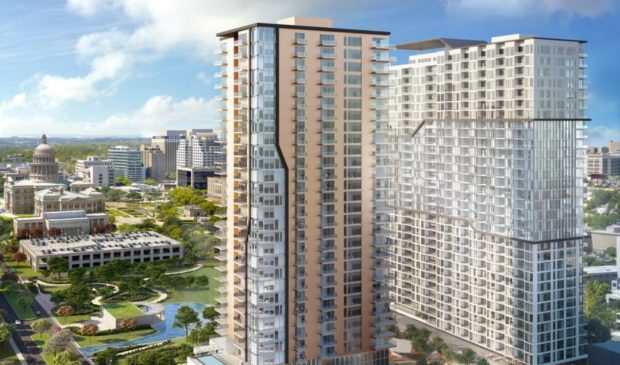Developer unveils conceptual designs for HealthSouth redevelopment
Tuesday, February 7, 2023 by
Nina Hernandez The Economic Development Department and developer Aspen Heights Partners kicked off the stakeholder engagement process by unveiling the conceptual plans for the redevelopment of the former HealthSouth site at 12th and Red River streets at the Design Commission on Jan. 23.
Commissioners voted unanimously to recommend the proposal to City Council as complying with the city’s Urban Design Guidelines.
Council authorized city staff to begin negotiation with Aspen Heights last fall. The development group plans to go back to Council for final approval of the project this spring or early summer. Before then, it will seek feedback and recommendation from several city commissions.
The conceptual plan represents Aspen Heights’ final offer. It includes two mixed-use, for-rent residential towers connected by a public plaza. The plan also includes space for a future hotel, which is not part of this public project, next to the south tower.
Amanda Swor of the Drenner Group, which is working with the Aspen Heights development team, said the project will be a “catalyst” for that area of downtown that is home to the Dell Medical Center and Waterloo Park. “We’re in a really unique location that really needs some life brought into it,” Swor said.
The two towers will be 37 stories each and will include a live music and arts venue, a food hall, public parking, a child care center and ground-floor retail. A 30,000-square-foot plaza between the towers is designed to preserve the Capitol View Corridor and act as an event space.
In total, the two towers will include 921 total housing units, 25 percent of which will be affordable to those at or below 60 percent of the median family income. Those units are to be managed by an affordable housing development partner.
The north tower will be a market-rate tower with 573 total units. The south tower as currently proposed would include 348 total units, 116 of which would be market-rate apartments. The other 232 would be affordable units, 117 of which would rent at rates affordable to those at 50 percent or below the median family income and 115 units for those at or below 60 percent MFI. Additionally, the units are to remain affordable for a 99-year lease term.
The project qualifies for the city’s Density Bonus Program, and the team plans to return to the Design Commission to apply for the program once it has completed a site plan proposal.
The proposal also includes activation of Red River Street with pedestrian-oriented and streetscape improvements, improvements to the south alley, and creation of a new alley to the north that will promote pedestrian and bike connectivity.
Community benefits negotiated by the city and Aspen Heights in addition to affordable housing include an on-site child care center, a public art mural and a commitment to “good faith efforts” to lease at least 30 percent of office space to local businesses. The developer will also endeavor to achieve Green Builder or LEED Gold certification.
Commissioner Evan Taniguchi praised the project but questioned the team about the raised nature of the plaza. “I’m wondering, what’s the experience going to be like at the edge of that?” he asked.
The design team said the current concept has a glass railing, likely behind a planter, along the east and south sides. Along the west side, the plans call for a raised platform that can double as a performance space and a place for the public to take in a view of the Capitol and Waterloo Park.
Margaret Shaw of the Economic Development Department said the city reviewers liked the idea of the raised plaza because it offers a view that the public isn’t often able to see outside of restaurants and private event venues.
“The element of that plaza is to be able to give anybody – visitor, tourist, resident – the ability to look over that Capitol and Waterloo Park,” she said. “So that was an exciting element from the city staff’s perspective to give that opportunity to everybody without having to make a purchase.”
The Austin Monitor’s work is made possible by donations from the community. Though our reporting covers donors from time to time, we are careful to keep business and editorial efforts separate while maintaining transparency. A complete list of donors is available here, and our code of ethics is explained here. This story has been changed since publication to clarify that a proposed hotel, if built, would be built by a private developer.
You're a community leader
And we’re honored you look to us for serious, in-depth news. You know a strong community needs local and dedicated watchdog reporting. We’re here for you and that won’t change. Now will you take the powerful next step and support our nonprofit news organization?








